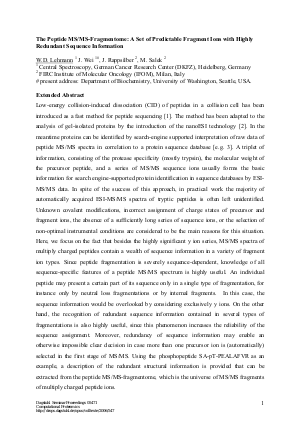The Peptide MS/MS-Fragmentome: A Set of Predictable Fragment Ions with Highly Redundant Sequence Information
Authors Wolf D. Lehmann, Junhua Wei, Juri Rappsilber, Mojiborahman Salek
-
Part of:
Volume:
Dagstuhl Seminar Proceedings, Volume 5471
Part of: Series: Dagstuhl Seminar Proceedings (DagSemProc) - License:
 Creative Commons Attribution 4.0 International license
Creative Commons Attribution 4.0 International license
- Publication Date: 2006-05-03
File

PDF
DagSemProc.05471.15.pdf
- Filesize: 219 kB
- 4 pages
Document Identifiers
Subject Classification
Keywords
- Peptides
- collision-induced dissociation
- tandem mass spectrometry
- electrospray
- peptide fragment ions
Metrics
- Access Statistics
-
Total Accesses (updated on a weekly basis)
0Document
0Metadata
Abstract
Upon low energy collision induced dissociation (CID), multiply protonated peptides generate a set of interdependent fragment ions detectable by MS/MS, the '[peptide]n+-fragmentome'. In particular dynamic fragmentation of [peptide]n+ ions in a collision cell generates information-rich MS/MS spectra. Currently, database-supported annotations of peptide MS/MS spectra are mainly based on a combination of peptide molecular weight and y type fragment ions, leaving a considerable number of good-quality peptide MS/MS spectra in proteomics studies unannotated. This situation may be improved by a more complete use of the structural information present in the [peptide]n+-fragmentome. The presentation provides an overview on the fragment ions of multiply protonated peptides and their connectivity, comprising a ions, b ions, y ions, and neutral loss reactions from the N-, and C-terminus, and internal b ions. In the low-mass region, the unique set of 19 y1 ions and of the 190 b2 ions carries a particular message, since these ions define the N-or C-terminal amino acid(s). Further, the b1 ions of the basic residues K, H, W, and R carry a specific N-terminal information, which is redundant to that contained in the corresponding b2 ions and in the N-terminal neutral loss peaks. Redundant information is also found in b and y ion series and in complementary b/y ion pairs. The latter are particularly abundant when generated by proline- or aspartate-induced backbone cleavages. From complementary b/y ion pairs the molecular weight of the precursor ion can be reconstructed to confirm or determine its molecular weight. This procedure is helpful in case a mixture of precursor ions is isolated or in case a precursor ion of very low abundance is isolated. Information about the precursor ion charge state is also delivered by precursor ion reconstruction using MS/MS data. In the analysis of covalently modified peptides, reporter ions are of particular importance. These ions can be used for mining of MS/MS data sets for the occurrence of selected modifications. Examples are presented for selected modifications, such as acetylation and phosphorylation. In phosphorylation analysis neutral loss reactions are highly important, and may also carry redundant information, when observed both from the molecular ion and from fragment ions. Search tools, which fully incorporate the current knowledge about the [peptide]n+-fragmentome will increase the scores of peptide/protein identifications by MS/MS and thus will increase the fraction of automatically assigned MS/MS spectra in proteomics studies.
Cite As Get BibTex
Wolf D. Lehmann, Junhua Wei, Juri Rappsilber, and Mojiborahman Salek. The Peptide MS/MS-Fragmentome: A Set of Predictable Fragment Ions with Highly Redundant Sequence Information. In Computational Proteomics. Dagstuhl Seminar Proceedings, Volume 5471, pp. 1-4, Schloss Dagstuhl – Leibniz-Zentrum für Informatik (2006)
https://doi.org/10.4230/DagSemProc.05471.15
BibTex
@InProceedings{lehmann_et_al:DagSemProc.05471.15,
author = {Lehmann, Wolf D. and Wei, Junhua and Rappsilber, Juri and Salek, Mojiborahman},
title = {{The Peptide MS/MS-Fragmentome: A Set of Predictable Fragment Ions with Highly Redundant Sequence Information}},
booktitle = {Computational Proteomics},
pages = {1--4},
series = {Dagstuhl Seminar Proceedings (DagSemProc)},
ISSN = {1862-4405},
year = {2006},
volume = {5471},
editor = {Christian G. Huber and Oliver Kohlbacher and Knut Reinert},
publisher = {Schloss Dagstuhl -- Leibniz-Zentrum f{\"u}r Informatik},
address = {Dagstuhl, Germany},
URL = {https://drops.dagstuhl.de/entities/document/10.4230/DagSemProc.05471.15},
URN = {urn:nbn:de:0030-drops-5472},
doi = {10.4230/DagSemProc.05471.15},
annote = {Keywords: Peptides, collision-induced dissociation, tandem mass spectrometry, electrospray, peptide fragment ions}
}
